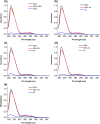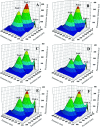Synthesis of novel genistein amino acid derivatives and investigation on their interactions with bovine serum albumin by spectroscopy and molecular docking
- PMID: 35548766
- PMCID: PMC9085648
- DOI: 10.1039/c8ra06691d
Synthesis of novel genistein amino acid derivatives and investigation on their interactions with bovine serum albumin by spectroscopy and molecular docking
Abstract
Genistein amino acid derivatives 4a-4d were synthesized and evaluated for their cytotoxic activities against MCF-7, Hela, MGC-803 and HCT-116 cell lines by MTT assays in vitro. The results revealed that compounds 4a-4d showed better activity than the parent compound genistein. Particularly, compound 4b displayed the most significant anticancer activity against MGC-803 with an IC50 value of 12.08 μM. In addition, the mechanisms of interaction between genistein, compounds 4a-4d and BSA were investigated via multi-spectroscopic techniques such as ultraviolet (UV) spectroscopy, fluorescence, circular dichroism (CD), and molecular docking under physiological conditions. The results suggested that endogenous fluorescence of BSA could be quenched by genistein and compounds 4a-4dvia forming BSA-compound complex, which meant a static quenching mechanism was involved. The negative values of enthalpy (ΔH) and entropy (ΔS) indicated that interactions between BSA and the ligands were spontaneous, and hydrogen bonding and van der Waals interactions were involved in the BSA-compound complexion formation. The UV, synchronous and 3D fluorescence results revealed that the micro-environment of tryptophan and conformation of BSA were changed after binding to ligands. CD analysis demonstrated the variation in the secondary structure and that the α-helix content of BSA decreased. Eventually, molecular docking was executed to forecast the binding forces and binding sites between BSA and compounds 4a-4d.
This journal is © The Royal Society of Chemistry.
Conflict of interest statement
There are no conflicts to declare.
Figures









Similar articles
-
[Binding interaction of harpagoside and bovine serum albumin: spectroscopic methodologies and molecular docking].Zhongguo Zhong Yao Za Zhi. 2018 Mar;43(5):993-1000. doi: 10.19540/j.cnki.cjcmm.2018.0031. Zhongguo Zhong Yao Za Zhi. 2018. PMID: 29676099 Chinese.
-
Combined spectroscopies and molecular docking approach to characterizing the binding interaction of enalapril with bovine serum albumin.Luminescence. 2017 Jun;32(4):481-490. doi: 10.1002/bio.3202. Epub 2016 Aug 23. Luminescence. 2017. PMID: 27550396
-
[Study on the interactions of genisten esterified derivatives with bovine serum albumin].Guang Pu Xue Yu Guang Pu Fen Xi. 2009 Dec;29(12):3369-74. Guang Pu Xue Yu Guang Pu Fen Xi. 2009. PMID: 20210172 Chinese.
-
Probing the binding of phenolic aldehyde vanillin with bovine serum albumin: Evidence from spectroscopic and docking approach.Spectrochim Acta A Mol Biomol Spectrosc. 2018 Oct 5;203:40-47. doi: 10.1016/j.saa.2018.05.023. Epub 2018 May 8. Spectrochim Acta A Mol Biomol Spectrosc. 2018. PMID: 29859491
-
Characterizing the binding interaction between antimalarial artemether (AMT) and bovine serum albumin (BSA): Spectroscopic and molecular docking methods.J Photochem Photobiol B. 2016 Sep;162:14-23. doi: 10.1016/j.jphotobiol.2016.06.025. Epub 2016 Jun 15. J Photochem Photobiol B. 2016. PMID: 27327124
Cited by
-
Genistein: A Potential Natural Lead Molecule for New Drug Design and Development for Treating Memory Impairment.Molecules. 2022 Jan 1;27(1):265. doi: 10.3390/molecules27010265. Molecules. 2022. PMID: 35011497 Free PMC article. Review.
-
Inhibition of the Maillard Reaction by Phytochemicals Composing an Aqueous Coffee Silverskin Extract via a Mixed Mechanism of Action.Foods. 2019 Sep 25;8(10):438. doi: 10.3390/foods8100438. Foods. 2019. PMID: 31557849 Free PMC article.
-
Interaction of eugenol-based anti-tuberculosis nanoemulsion with bovine serum albumin: A spectroscopic study including Rifampicin, Isoniazid, Pyrazinamide, and Ethambutol.Heliyon. 2024 Mar 19;10(7):e28306. doi: 10.1016/j.heliyon.2024.e28306. eCollection 2024 Apr 15. Heliyon. 2024. PMID: 38571616 Free PMC article.
-
Towards targeted cancer therapy: Synthesis, characterization, and biological activity of a new Cu(II)-ibuprofen-2,2'-dipyridylamine metal complex.Heliyon. 2024 Dec 18;11(1):e41323. doi: 10.1016/j.heliyon.2024.e41323. eCollection 2025 Jan 15. Heliyon. 2024. PMID: 39811293 Free PMC article.
References
-
- Carter D. C. Chang B. Ho J. X. Keeling K. Krishnasami Z. FEBS J. 1994;226:1049–1052. - PubMed
LinkOut - more resources
Full Text Sources
Other Literature Sources

